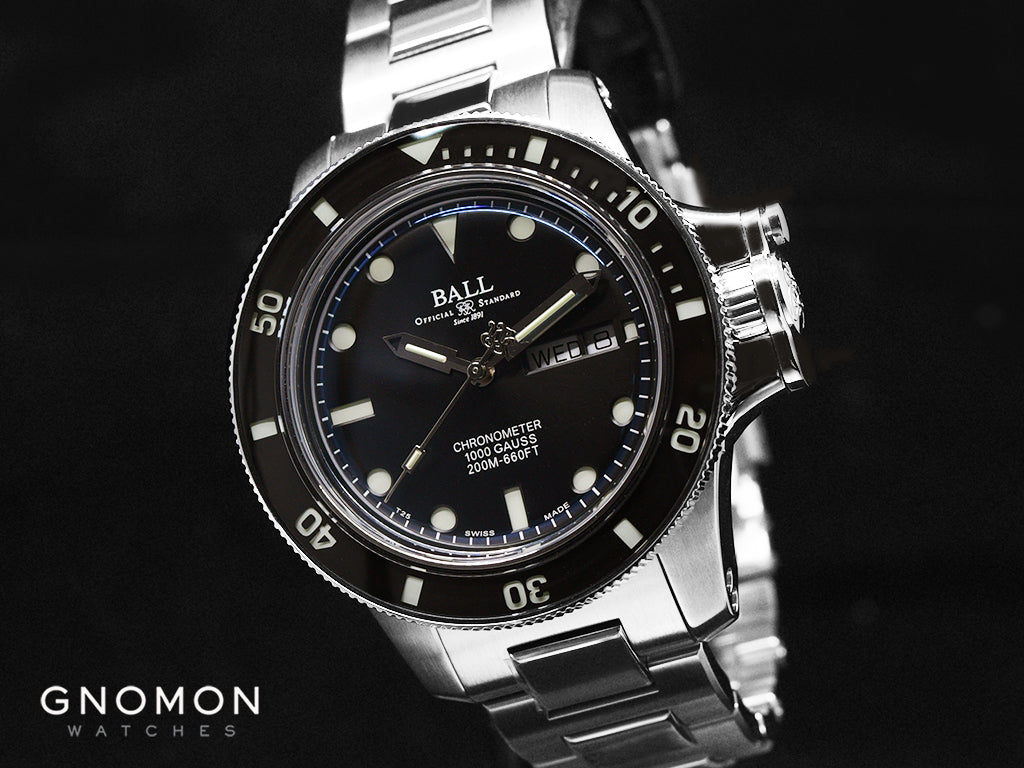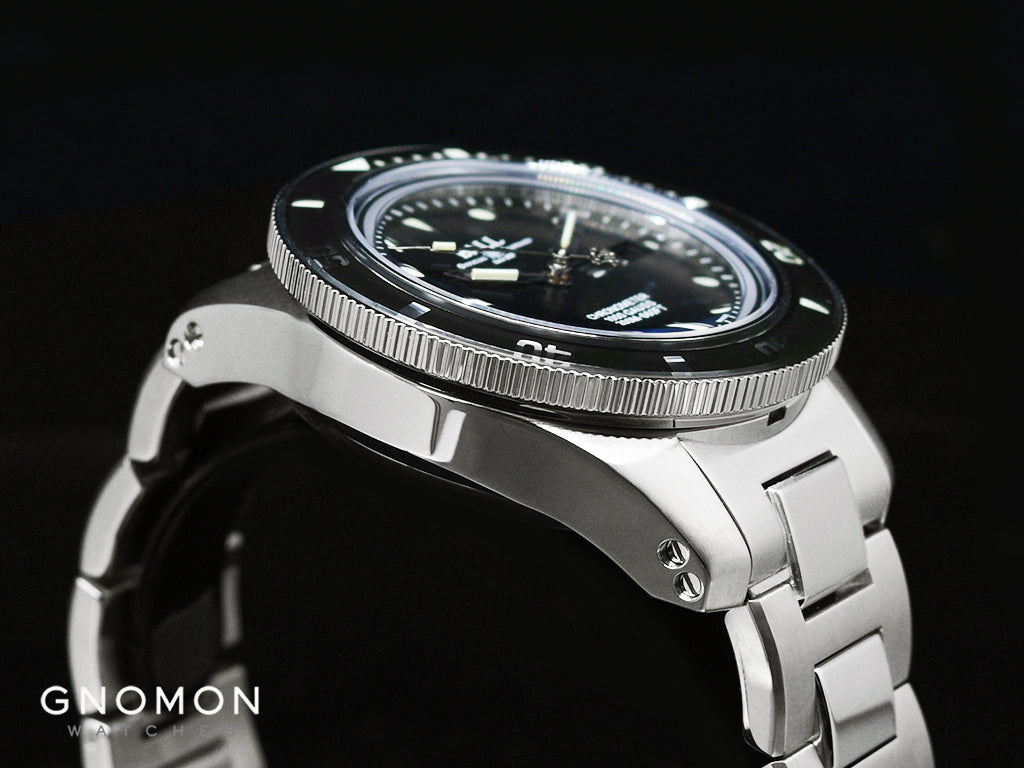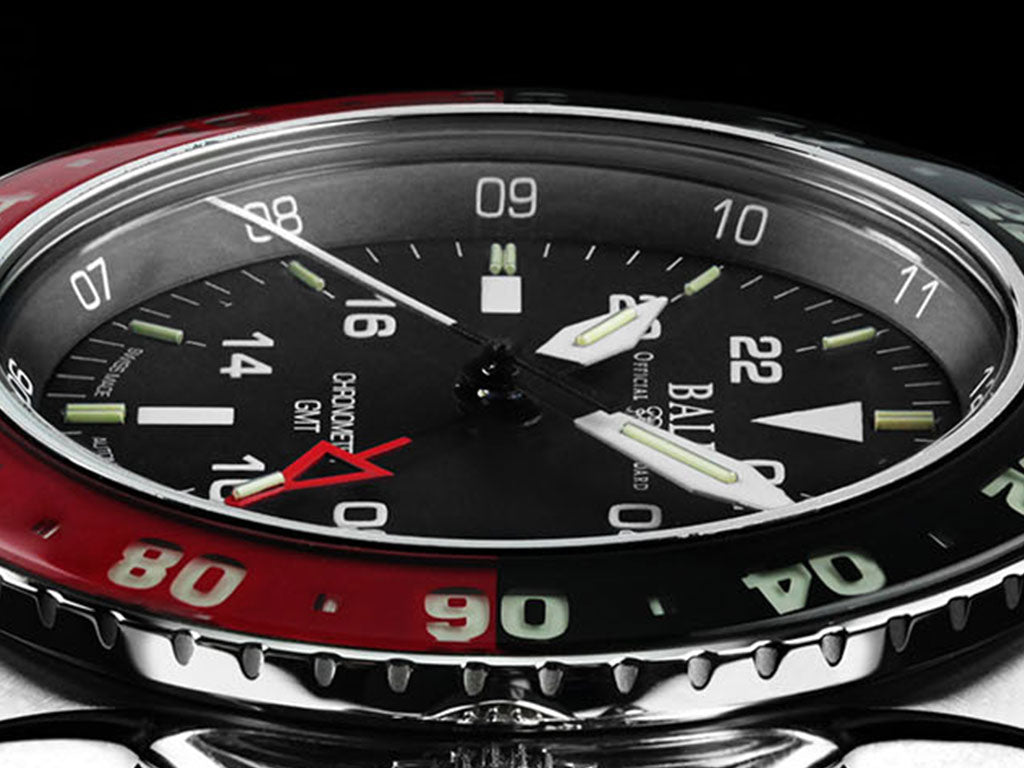Nothing in cart

Ball Engineer Hydrocarbon: The Queen Crown
The Ball Watch Company is no stranger to the world of watchmaking. They've been making timepieces since the late 1800's, always with a focus on accuracy. The company was founded after a train crash which resulted in a push to set time protocols to avoid future rail disasters. An accurate watch made work easier, which is why the Ball Watch Company was founded. Today, watches are aesthetically very different from those historical objects, but the ethos remains largely the same. It's a tough, feature-heavy watch designed with readability and precision, but with a contemporary exterior to captivate modern customers.
Original Ball Engineer Hydrocarbon Ref. DM2118B-SCJ-BK
This is not the first engineer hydrocarbon produced by Ball watch, but they call it "Original". As it’s my first covering up the Ball Engineer Hydrocarbon watch, I am now excited to see the new Ball Engineer Hydrocarbon Original. Reference DM2118B-SCJ-BK Ball Engineer Hydrocarbon Original is not only a great timepiece, it combines many desirable technologies, both inside and out. While "Original" isn't all that expensive, it's not a budget watch and understanding where its value comes from requires a little study.

Ball was able to answer one of the most popular demands of its customers for Hydrocarbon Original, and that is to make a dial that uses a luminous tritium gas cylinder but has a more sleek look that comes without making a limited number of tubes on the dial. For a tactical and modern look, tritium gas cylinders are allowed. Even so, only a few watches with gas cylinders on the dial that look "classic".
That's all changing, as watches are now starting to use a flatter (versus cylinder) tube, and overall the dial and bezel of the watch use about 30 of them. These flat tubes can be used in a variety of ways, and here Ball manages to create a Submarine-style dial with a sandwich effect. Basically, there is a top black dial with a hole in it for the hour markers that sit on top of the flat tritium gas cylinder layer. These hour mark windows can be in any shape they want with a shining tube right underneath. The results are amazing, and this is one of the Hydrocarbon Ball watches with the best look.

We saw the same effect on a rotating diver-style bezel - with a tritium gas cylinder under the ring with a minute marker inside. A sapphire crystal is on top of the bezel, which makes Ball one of the few (and desirable) sports watches to have a sapphire crystal both on the dial and over the bezel. It is more expensive but also more desirable than ceramic (and sapphire is a little more scratch resistant, to boot). My compliments to Ball for mastering the rotating bezel action (super smooth with a great click).
The Hydrocarbon Engineer's case has aged well, but what I've found is that the Ball has been quietly updating and refining the case over time. For example, I compared Original Hydrocarbon to Ball Engineer Hydrocarbon Ceramic XV from about eight years ago, and the casing is completely different despite the similar shape. I really admire Ball for following some great brands that are constantly improving the core theme. The case is of excellent quality stainless steel with a brushed and polished surface. It is water resistant up to 200 meters, which seems low compared to many other ball diver watches that are water resistant up to 300 meters. It doesn't really matter, but I find that fact a bit odd.

From the back of the watch, but the bezel is about 42mm wide, which is how I measured the watch case size. What's also intriguing is that the Ball Engineer Hydrocarbon Original watch wears like 40mm wide. Maybe. The case is also 14.55mm thick and has a durability of approx. 51mm lug-to-lug distance. The ball doesn't mess with the typical crown protection system. The locking clasp that folds under the crown is intended to ensure that the user replaces the crown completely.
This watch has more durability features than just water resistance. Next comes the antimagnetic shield, which provides a resistance of up to 1,000 Gauss. Then, you have a range of anti-shock systems that include Ball Amortiser, SpringSEAL and SpringLOCK. I'll spend a moment on the latter and the rest of the features, in brief, designed to protect the movement from breaking if it is subjected to shocks, or to prevent the machine from having speed errors due to shock or vibration.

Some of the above characteristics are part of the situation, but changes to the movement itself are stuff like the SpringLOCK. SpringLOCK was created for Ball when Philippe Antille was working for the brand. Most of these other discoveries also came from his mind, I'm sure. The SpringLOCK is actually a small cage that is inserted around a balance spring in mechanical motion. These cases reduce the distance the springs are compressed by shock and gravity. The farther the distance the spring travels, the more errors in the resulting velocity will occur. This happens when the watch falls, but more importantly if it shocks. Antille tested the SpringLOCK in action on the wrist of KISS drummer Eric Singer during a concept. As a hardcore watch lover and collector, Springer is very much obliged to work together. The idea is to test the time before the concert and see if the watch has lost its accuracy during the concert while it is on a drummer's wrist. Philippe smiled happily and shared, "It worked!"

The basic movement used for the Original Hydrocarbon Engineer is the Swiss ETA 2836, but it has been heavily modified, as I mentioned, and Ball calls it the BALL RR1102-CSL caliber. Its functions include time and calendar with day and date indicators. This movement operates at 4Hz with a power reserve of about two days. An added plus to this movement is that Ball has the COSC Chronometer certification (for accuracy and performance) on every Original Hydrocarbon watch.
What hasn't changed over the last few years in the Hydrocarbon Engineer collection is the band and clasp that is attached. This isn't a bad thing, but over the years I'd like Ball to experiment with more abilities to micro-customize the bracelet. Although it depends entirely on your anatomy, I think the bracelet is perfect, despite the fact that Ball includes half the link on the bracelet. I still wear and enjoy watches and love the bracelet, unlike some other watches, I get a size that fits on my own wrist.

The steel bracelet uses double screws to attach to the case and generally looks very attractive. Ball uses his own butterfly-style spread which is nice and bold, but also rather simple. Each application tip has its own little diver style extension, which may come in handy on occasion.

The Ball Hydrocarbon Engineer range has never been more important, with its many features, some best-in-class execution for multiple elements, and a distinctive and polished design, and the Original Hydrocarbon Engineer has long been one of the most attractive choices out there.

The price for the Original Ball Engineer DM2118B-SCJ-BK Hydrocarbon reference is $2,380 USD.
Ball Hydrocarbon AeroGMT II Engineer
Despite its name, the watches we see today are not intended for engineers, but for airline pilots and travelers who frequently cross time zones. Ball's Engineer Hydrocarbon AeroGMT II (hereinafter referred to as AeroGMT) is a rugged GMT watch that combines a vintage look with modern technology. Let's break it.

Case
The AeroGMT not only looks like part of a watch ready for the cockpit, but is actually built to work. There are several ways Ball enhances the case to protect the watch that you can't see from the outside. First, there's 7,500 G worth of shock protection. This means that the case can take a knock from a pendulum impact testing machine with a 1.5 meter stroke. While this test sounds a bit arbitrary, it basically means that the watch will more than stand up to the daily bumps and knocks and keep ticking. Additionally, there is 4,800 A / m magnetic resistance, which again, is more than sufficient to withstand everyday wear and tear and occasional exposure to more significant magnetic fields. Standards show that after exposure to 4,800 A / m, the watch will not deviate by more than 30 seconds a day. But that's new on the inside.

The AeroGMT has a 42mm stainless steel shell on the outside with a combination of brushed and polished surfaces. From top to bottom, you'll see a two-way red and blue sapphire bezel illuminated through the tritium gas canister, although you will never notice it just by looking at the bezel itself. The ball isn't aggressive in making the tube clear - actually, I couldn't tell just by looking at the watch. This approach is certainly the right call here and it lends the aesthetics of the much cleaner bezels. Sapphires are a welcome choice, and give the bezels a slightly dated look without sacrificing durability. It is transparent so the illumination can shine, and has the same scratch-resistant properties as a crystal dial made of the same material.

Another feature that stands out when looking at the watch from top to bottom is the locking of the crown protection system at 3 o'clock. The guards themselves look almost sculpted from the base metal, thanks to their curved nature. On the end of the guard, there is a rotating lock which releases by pressing a small button on one edge of the lock plate. I think the entire crown lock is kind of eye-catching, especially since the crown is hidden enough in the guard to protect it. Everything looks more ornamental than its function. Of course, there's no rule that says everything on the watch has to work, but something impressive like the crown system here would be better if it scaled down a little.

In profile, AeroGMT is quite fascinating. The side facing the crown is thick and smooth, featuring a wide polished surface. There are screws instead of standard spring bars here, with two of them at each lug to secure the bracelet, ensuring that there's no way the watch will come off unless you 100% intend to remove it.
Dial and Hands
The first thing that comes to my mind when I think of Ball is the use of tritium gas cylinders instead of luminous paint. In total, 43 such tubes are used on the AeroGMT, arranged on the dial, hand and bezel. The resulting effect is constant light without requiring exposure to a light source. Even though the sparkle wasn't quite as bright as the C3 or the freshly charged BGW9, the light was sure to be there all night. Ball states that at the AeroGMT, the addition of multiple gas cylinders is required for pilots in a dimly lit cockpit, but anyone who needs to read the time at night will appreciate the addition of this technology.

Relative to other watches, the dial itself is on the smaller side. The base material is a grained textured surface presented in a deep navy blue. The Ball logo is at 12 o'clock, offset by "CHRONOMETER GMT" just above the 6 o'clock position. As a 24 hour indicator for the GMT hour side, the 12 hour scale on the dial doubles, with Arabic numerals written in white counting up to 24 all around the dial. The scale is also repeated on the bezel, allowing the user to track additional time zones using the GMT off-set. Even though the dial is relatively small compared to other watches and there's a lot going on, it's still easy to read.
To tell the time, you will be delighted to read a set of large, white, sword-shaped hands that have a floating effect thanks to the darkened plinth on each hand. The hour and minute hands each have a long gas cylinder placed in the center of the hand to help distinguish it from other gas cylinders embedded in the dial. The black second hand is present and quick to read with a white tip. Opposite the gas cylinder in the seconds hand is the large "double R" logo of the Ball which acts as a counterweight to the weighted end. In addition to the standard needle set, there is a GMT needle punched in a bright red color that complements the lower half of the sapphire bezel. You will see a date window with a very simple black and white date wheel at 3 o'clock.

Movement
Beat inside the AeroGMT is the RR1201-C Ball RR1201-C automatic GMT movement with chronometer certification. This movement is based on the 2893-2 GMT ETA movement with a few additional finishes and COSC certified chronometer class adjustments. To operate the GMT hand, you must pull the crown out to the first stop and turn it clockwise to skip the GMT hand. Rotating counterclockwise adjusts the date. If you pull the knob completely, you can adjust the main needle set. The movement's COSC certification is a great addition to the basic ETA movement and does help to justify the price of the watch. The improved accuracy is also testament to Ball's long history of advances in chronometry.

Strap and Wear
The AeroGMT ships with a thick bracelet with raised, polished center joints. This bracelet tapers about 2mm from the lugs to the clasp, reducing weight and providing extra comfort. If I had to choose one word to describe the bracelet, it would be solid. Every link is clearly established and completed. The clasp is on the larger and heavier side, and has some sharp edges that are clearly visible when wearing the watch. I love adjustable bracelets - no matter what size your wrist is, you should be able to find one that fits comfortably. There are half a link on either side of the buckle, and each side has a folding extension instead of the micro-adjustment hole in the buckle itself. For clasp opening and closing, there's a well-implemented dual push button system, providing confidence that the clasp will stay closed and the watch won't come off your wrist. The bracelet is attached to the case with flat head screws, so strap replacement will require a screwdriver to complete, but the AeroGMT makes the most sense on a bracelet. I can't see her wearing too well on nylon straps, but there is potential in fat leather straps.

The AeroGMT is difficult to miss on the wrist. A case wide 42mm by 13.85mm high and a large, conspicuous crown on the right side makes for a watch with a serious wrist look. Lug to lug, AeroGMT size at 50mm. From the edge of the bezel (which hangs slightly over the case) to the edge of the crown, this watch is less than 48mm long. On my 6.75-inch wrist, it's easy to tell that this is a big watch that wears more than the recommended 42mm case dimensions.

This watch will be worn on the bigger side even though it doesn't have the crown lock system in place, but I don't think it would be as attractive as a watch if the crown wasn't there. Therefore, the crown gets in the way a little and when you bend your wrist it will hit your hand. Overall, however, I find it balanced, even considering the weight and proportions of the watch. This is due to the solid bracelet that balances the watch head on your wrist.
Conclusion
The Ball AeroGMT II is a unique watch. It mixes modern and vintage look and features, but does it in a way that ends up working well together. Everything about the AeroGMT II, whether it's the stainless steel shell, the crown security device or the highly adjustable clasp on the band, is strong when looking at the side nut. At $2,890, the AeroGMT II is not an impulsive buy for most of us, and is in a very competitive price range. But if you're looking for something that sticks out of the pack, then this Ball might just be the watch for you.




